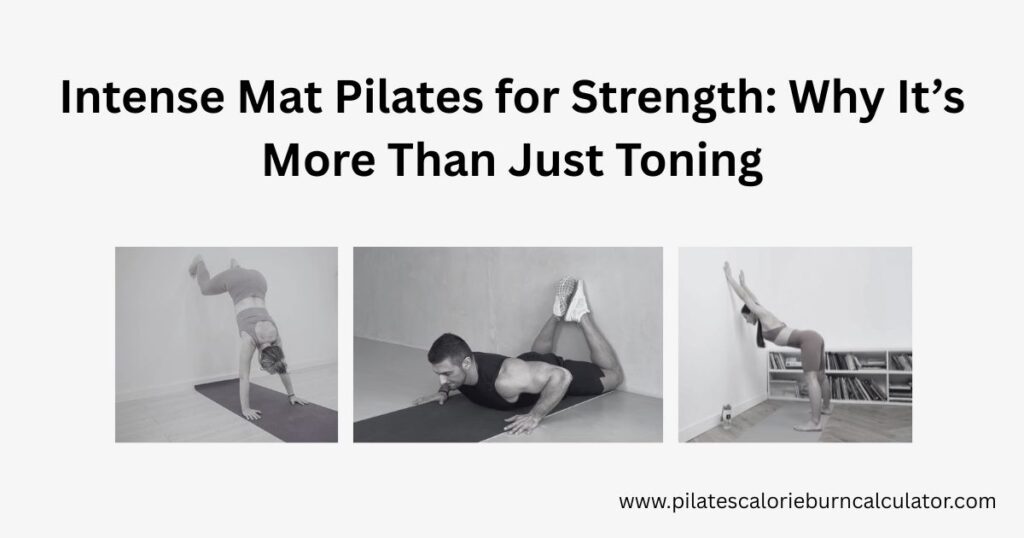
When most people think of Pilates, they picture long, lean muscles and improved flexibility. But what if we told you that Pilates mat workouts can be a powerhouse for building serious strength—not just toning?
Contrary to popular belief, Pilates isn’t just about stretching or lengthening muscles. When performed with intensity, precision, and progressive overload, mat Pilates can increase muscle mass, enhance functional strength, and even rival weight training in some aspects.
In this article, we’ll dive into:
✓ How Pilates builds strength (not just endurance)
✓ Key exercises for muscle growth
✓ Science-backed benefits of intense mat Pilates
✓ How to structure a strength-focused routine
The Science Behind Pilates for Strength
1. Progressive Overload Without Weights
Unlike traditional weightlifting, Pilates uses bodyweight leverage, resistance bands, and instability to challenge muscles. Research shows that slow, controlled movements with high tension can stimulate muscle hypertrophy similarly to weights (Journal of Strength and Conditioning Research, 2021).
How it works:
Longer time under tension (e.g., slow Roll-Ups) increases muscle fiber recruitment.
Unstable surfaces (like single-leg balances) force deeper muscle engagement.
Compound movements (e.g., Teaser to Boomerang) work multiple muscle groups at once.
2. Full-Body Functional Strength
Pilates doesn’t isolate muscles—it trains integrated movement patterns, which translates to real-world strength (lifting groceries, climbing stairs, sports performance).
Key muscle groups strengthened:
Core (beyond just abs): Transverse abdominis, obliques, spinal erectors
Posterior chain: Glutes, hamstrings, lower back
Upper body: Shoulders, arms (via pushing/pulling resistance)
5 Best Mat Pilates Exercises for Strength
1. The Teaser (Advanced)
Muscles worked: Entire core, hip flexors, quads
Why it builds strength: Requires simultaneous control of flexion and balance, forcing maximal core engagement.
Progression: Hold legs at 45° for 10 seconds between reps.
2. Push-Up to Side Plank
Muscles worked: Chest, triceps, shoulders, obliques
Why it builds strength: Combines horizontal push (push-up) with anti-rotation (side plank).
Progression: Add a leg lift in side plank.
3. Swan Dive
Muscles worked: Spinal erectors, glutes, hamstrings
Why it builds strength: Unlike crunches, this back extension builds posterior chain power.
4. Single-Leg Stretch with Resistance Band
Muscles worked: Hip flexors, deep core
Why it builds strength: The band adds load to the working leg, increasing tension.
5. Corkscrew with Weighted Ball
Muscles worked: Obliques, shoulders, hip flexors
Why it builds strength: The added weight forces rotational control under load.
How to Structure a Strength-Focused Mat Pilates Routine
Sample Workout (3x/week)
Power Hundred (with leg pulses) – 3x 30 sec
Push-Up to Side Plank – 3x 8/side
Swan Dive (with 2-sec hold at top) – 3x 10
Single-Leg Stretch (with band) – 3x 12/side
Corkscrew (with 5-lb ball) – 3x 10/side
Rest: 30 sec between sets
Why This Beats Traditional “Toning” Pilates
| Metric | Traditional Pilates | Strength Pilates |
|---|---|---|
| Muscle Adaptation | Endurance-focused | Hypertrophy possible |
| Equipment | Often just mat | Bands, weights, sliders |
| Progression | Minimal | Systematic overload |
| Functional Carryover | Better posture | Athletic performance |
Who Should Try Strength Pilates?
✓ Weightlifters seeking balanced mobility
✓ Anyone plateaued in traditional toning
Conclusion
Mat Pilates isn’t just stretching—it’s a legitimate strength-building tool when programmed correctly. By focusing on progressive overload, compound movements, and controlled tension, you can build real muscle without stepping foot in a gym.
Ready to redefine Pilates? Your mat is waiting.
Share with someone who thinks Pilates is “just for toning”!